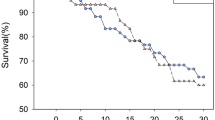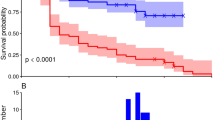Abstract
A number of cotton varieties have been genetically transformed with genes from Bacillus thuringiensis (Bt) to continuously produce Bt endotoxins, offering whole plant and season-long protection against many lepidopteran larvae. Constant whole-plant toxin expression creates a significant opportunity for non-target herbivores to acquire and bio-accumulate the toxin for higher trophic levels. In the present study we investigated movement of Cry1Ac toxin from the transgenic cotton plant through specific predator-prey pairings, using omnivorous predators with common cotton pests as prey: (1) the beet armyworm, Spodoptera exigua (Lepidoptera: Noctuidae), with the predator Podisus maculiventris (Heteroptera: Pentatomidae); (2) the two-spotted spider mite, Tetranychus urticae (Acarina: Tetranychidae), with the predatory big-eyed bug Geocoris punctipes (Heteroptera: Geocoridae) and (3) with the predatory damsel bug Nabis roseipennis (Heteropera: Nabidae); and (4) the thrips Frankliniella occidentalis (Thysanoptera: Thripidae) with the predatory pirate bug Orius insidiosus (Heteroptera: Anthocoridae). We quantified Cry1Ac toxin in the cotton plants, and in the pests and predators, and the effects of continuous feeding on S. exigua larvae fed either Bt or non-Bt cotton on life history traits of P. maculiventris. All three herbivores were able to convey Cry1Ac toxin to their respective predators. Among the herbivores, T. urticae exhibited 16.8 times more toxin in their bodies than that expressed in Bt-cotton plant, followed by S. exigua (1.05 times), and F. occidentalis immatures and adults (0.63 and 0.73 times, respectively). Of the toxin in the respective herbivorous prey, 4, 40, 17 and 14% of that amount was measured in the predators G. punctipes, P. maculiventris, O. insidiosus, and N. roseipennis, respectively. The predator P. maculiventris exhibited similar life history characteristics (developmental time, survival, longevity, and fecundity) regardless of the prey’s food source. Thus, Cry1Ac toxin is conveyed through non-target herbivores to natural enemies at different levels depending on the herbivore species, but continuous lifetime contact with the toxin by the predator P. maculiventris through its prey had no effect on the predator’s life history. The results found here, supplemented with others already published, suggest that feeding on Cry1Ac contaminated non-target herbivores does not harm predatory heteropterans and, therefore, cultivation of Bt cotton may provide an opportunity for conservation of these predators in cotton ecosystems by reducing insecticide use.



Similar content being viewed by others
References
Adamczyk JJ Jr, Holloway JW, Church GE, Leonard BR, Graves JB (1998) Larval survival and development of the fall armyworm (Lepidoptera: Noctuidae) on normal and transgenic cotton expressing the Bacillus thuringiensis Cry1A(c)–endotoxin. J Econ Entomol 91:539–545
Al-Deeb MA, Wilde GE, Higgins RA (2001) No effect of Bacillus thuringiensis corn and Bacillus thuringiensis on the predator Orius insidiosus (Hemiptera: Anthocoridae). Environ Entomol 30:625–629
Bai YY, Jiang MX, Cheng JA, Wang D (2006) Effects of Cry1Ab toxin on Propylea japonica (Thunberg) (Coleoptera: Coccinellidae) through its prey, Nilaparvata lugens Stål (Homoptera: Delphacidae), feeding on transgenic Bt rice. Environ Entomol 35:1130–1136
Bottrell DG, Barbosa P, Gould F (1998) Manipulating natural enemies by plant variety selection and modification: a realistic strategy? Annu Rev Entomol 43:347–367
De Clercq P (2000) Predaceous stinkbugs (Pentatomidae: Asopinae). In: Schaefer CW, Panizzi AR (eds) Heteroptera of economic importance. CRC Press, Boca Raton, Florida, pp 737–889
Dutton A, Klein H, Romeis J, Bigler F (2002) Uptake of Bt-toxin by herbivores feeding on transgenic maize and consequences for the predator Chrysoperla carnea. Ecol Entomol 27:441–447
Ellington J, Southward M, Carrillo T (1997) Association among cotton arthropods. Environ Entomol 26:1004–1008
Harwood JD, Wallin WG, Obrycki JJ (2005) Uptake of Bt endotoxins by nontarget herbivores and higher order arthropod predators: molecular evidence from a transgenic corn agroecosystem. Mol Ecol 14:2815–2823
Henneberry TJ, Jech LF, de laTorre T (2001) Effects of transgenic cotton on cabbage looper, tobacco budworm, and beet armyworm (Lepidoptera:Noctuidae) larval mortality and development and foliage consumption in the laboratory. Southwestern Entomol 26:325–338
Huesing J, English L (2004) The impact of Bt crops on the developing world. AgBioForum 7:84–95
Obrist LB, Klein H, Dutton A, Bigler F (2005) Effects of Bt maize on Frankliniella tenuicornis and exposure of thrips predators to prey-mediated Bt toxin. Entomol Exp Appl 115:409–416
Obrist LB, Dutton A, Romeis J, Bigler F (2006) Biological activity of Cry1Ab toxin expressed by Bt maize following ingestion by herbivores arthropods and exposure of the predator Chrysoperla carnea. BioControl 51:31–48
SAS Institute (1999–2001) SAS/STAT User’s guide, version 8.02, TS level 2MO. SAS Institute Inc., Cary, North Caroline
Schaefer CW, Panizzi AR (2000) Heteroptera of economic importance. CRC Press, Boca Raton, Florida
Schoenig SE, Wilson LT (1992) Patterns of spatial association between spider-mites (Acari, Tetranychidae) and their natural enemies on cotton. Enviorn Entomol 21:471–477
Stewart SD, Adamczyk Jr JJ, Knighten KS, Davis FM (2001) Impact of Bt cotton expressing one or two insecticidal proteins of Bacillus thuringiensis Berliner on growth and survival of Noctuid (Lepidoptera) larvae. J Econ Entomol 94:752–760
Torres JB, Ruberson JR (2005) Canopy- and ground-dwelling predator arthropods in Bt and non-Bt cotton fields: patterns and mechanisms. Environ Entomol 34:1242–1256
Torres JB, Ruberson JR (2006) Interactions of Bt-cotton and the omnivorous big-eyed bug Geocoris punctipes (Say), a key predator in cotton fields. Biol Control 39:47–57
Torres JB, Ruberson JR, Adang MJ (2006) Expression of Bacillus thuringiensis Cry1Ac protein in cotton plants, acquisition by pests and predators: a tritrophic analysis. Agric For Entomol 8:191–202
Wilson LT, Trichilo PJ, Gonzalez D (1991) Natural enemies of spider mites (Acari: Tetranychidae) on cotton: density regulation or casual association? Environ Entomol 20:849–856
Zhang GF, Wan FH, Liu WX, Guo JY (2006) Early instar response to plant-delivered Bt-toxin in a herbivore (Spodoptera litura) and a predator (Propylea japonica). Crop Prot 25:527–533
Zhang GF, Wan FH, Lövei GL, Liu WX, Guo JY (2006) Transmission of Bt toxin to the predator Propylaea japonica (Coleoptera: Coccinellidae) through its aphid prey feeding on transgenic Bt cotton. Environ Entomol 35:143–150
Zwahlen C, Nentwig W, Bigler R, Hilbeck A (2000) Tritrophic interactions of transgenic Bacillus thuringiensis corn, Anaphothrips obscurus (Thysanoptera: Thripidae), and the predator Orius majusculus (Heteroptera: Anthocoridae). Environ Entomol 29:846–850
Acknowledgments
We are greatly indebted to Evelyn Perry and Stephen Mullis (Horticulture/UGA, Tifton) for allowing us to use their lab facilities to run ELISA assays. This research was supported in part by Georgia Cotton Commission and Cotton Incorporated and “Coordenação de Aperfeiçoamento de Pessoal de Nível Superior” (CAPES Foundation Brazil) with grant to J.B.T.
Author information
Authors and Affiliations
Corresponding author
Rights and permissions
About this article
Cite this article
Torres, J.B., Ruberson, J.R. Interactions of Bacillus thuringiensis Cry1Ac toxin in genetically engineered cotton with predatory heteropterans. Transgenic Res 17, 345–354 (2008). https://doi.org/10.1007/s11248-007-9109-8
Received:
Accepted:
Published:
Issue Date:
DOI: https://doi.org/10.1007/s11248-007-9109-8




